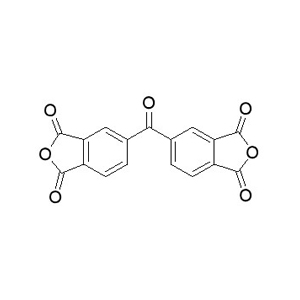Aure Chemical Delivers Excellence in BTDA
3,3′,4,4′-Benzophenone Tetracarboxylic Dianhydride (BTDA, CAS 2421-28-5) is an aromatic dianhydride primarily used as a monomer for synthesizing polyimides and as a curing agent for epoxy resins, offering high thermal stability, mechanical strength, flexibility, solubility, and processability due to its keto and carbonyl groups.
Basic Information of BTDA
| Product Name | 3,3',4,4'-Benzophenonetetracarboxylic dianhydride |
|---|
| Abbreviation | BTDA |
|---|
| CAS Number | 2421-28-5 |
|---|
| Molecular Formula | C17H6O7 |
|---|
| Molecular Weight | 322.23 g/mol |
|---|
| Appearance | Off-white to brown needles or crystalline powder |
|---|
| Purity | ≥98% |
|---|
| Package | 1kg/bottle, 20kg/drum, or customized |
|---|
| Molecular formula |  |
|---|
Key Properties
High thermal stability and rigidity (aromatic dianhydride backbone)
Keto / carbonyl groups increase spacing, improving solubility / processability in polyimide precursors
Good mechanical strength in resulting polymers
Compatible with a wide range of diamines to form high-performance polyimides and copolyimides
Used in electronic, memory, dielectric, and film applications due to favorable dielectric and structural characteristics
Key Applications of BTDA
Electronics and Microelectronics: Employed in polyimide films for electrical insulation, flexible copper-clad laminates (FCCL) in smart devices (e.g., phones, tablets, 5G infrastructure), wire enamels/varnishes for electric motors, dielectric layers in organic field-effect transistors (OFETs) and memory devices, and materials for organic light-emitting diodes (OLEDs) and organic photovoltaics.
Aerospace and Military: Utilized in polyimide foams for thermal and acoustic insulation in military vessels, matrix resins for fiber-reinforced composites, and molding powders for industrial parts in extreme environments.
Energy and Photocatalysis: Applied in photosensitizers for photocatalytic dye degradation (e.g., methylene blue), dye-sensitized solar cells (DSSCs), and other photocatalytic reactions.
Textiles and Filtration: Serves as a cross-linker for wrinkle-resistant fabrics, photo-reactive agents in antibacterial cotton fabrics, fibers for hot-gas filtration, and air filtration membranes (e.g., electrospun antibacterial poly(vinyl alcohol)/Ag nanoparticles).
Other Industrial Uses: Incorporated into epoxy resins for powder coatings and molding powders in industrial/electrical applications, polyimides for food contact materials (up to 43% as co-monomer), and as an intermediate in plastic goods production.
Detailed COA / TDS / MSDS are available upon request. Please Contact Us for more information.

